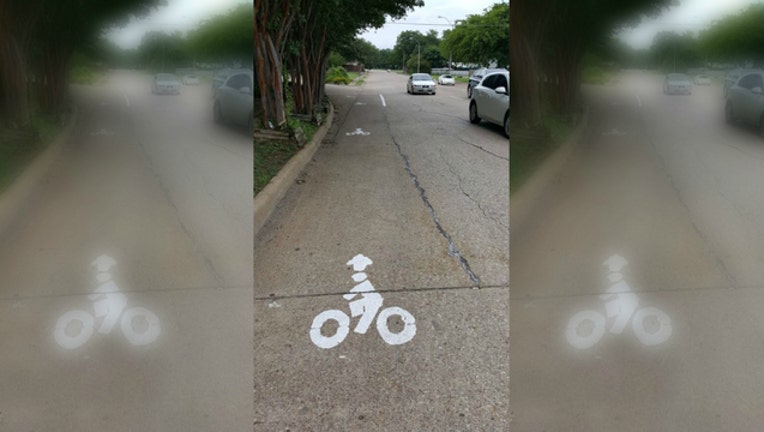Activists create rogue bike lanes on city streets to draw attention to safety

The Dallas Transformation Department is making its own bike lanes around the city to draw attention to bicycle safety
DALLAS (AP) -- A makeshift bike lane divider made of painted two-by-fours and PVC pipes lasted three days on a busy Dallas street last month before the city removed it, which was two days longer than its creators expected.
The $100 structure was the work of the Dallas Transformation Department, one of several like-minded groups of anonymous Twitter users who have taken a do-it-yourself approach to making road improvements in cities stretching from New York and Boston to San Francisco.
Activists say a flower planted in a pothole or a line of cones or toilet plungers to keep cars from drifting into bike lanes can have the magical psychological effect of getting drivers to slow down and watch for cyclists and pedestrians. Although the measures are meant to be temporary, they can show the public what could be and spur cities to make permanent improvements.
"These transformation groups are creating change, and we support that," said Kathleen Ferrier, a spokeswoman for the Vision Zero Network, a group dedicated to eliminating traffic fatalities around the world. "What's happening with guerrilla tactics is that they are creating more urgency. It's helping people imagine and experience what change could be like."
Last month's project was the first for the Dallas Transformation Department, but it plans more.
"We knew it wouldn't be permanent. It would take a few times, but we believe people should have the power to give their neighborhoods value," said Layne, a group spokesman who declined to give his last name because the project was technically considered vandalism by the city.
City officials say it's not that simple. Business owners complain when street parking is replaced with bike lanes, and firefighters worry that separated bike lanes could impede their emergency responses.
And there's usually a shortage of funds, said Jared White, who manages Dallas' bicycle transportation program within the Mobility and Street Services Department. Striping a buffered bike lane can cost $50,000 a mile or more if a crosswalk needs to be altered, and moving curbs to install bike lanes can cost millions, he said.
"It's difficult to get something on the ground right now," White said. "I understand the frustration, but there is a lot of planning and engineering that goes into bike lanes. On the street where they put the bike lane is right where we're about to put one in. It's going to happen within the next couple of years."
Dallas spent an estimated $300 and three hours removing the unauthorized bike lane divider because it didn't meet federal and state regulations. It also presented a safety hazard, said Auro Majumdar, an assistant director of transportation operations for the city.
"The bicycle lane endangered any bicyclist using the illegal lane by exposing them to head-on collisions with a motor vehicle legally travelling in the marked travel lane," he said.
Despite concerns with how pop-up projects are installed, they are working in several cities. In San Francisco, the Transformation Department's biggest success is a makeshift bike lane that officials decided to keep until the city can install a permanent one. And in Chicago, artist Jim Bachor is providing a small fix to the city's pothole problem by filling them with mosaics that display candy bars, popsicles and flowers. The city hasn't approved his creations, which number more than 50 since he began in 2013, but they haven't been removed, either.
"Temporary demonstration projects are a win-win situation," Ferrier said. "People dubious about change can experiment with it. They usually don't change back."
White acknowledged that more people are pushing for improvements in Dallas, where the streets have long been considered some of the worst in the country for bicyclists. From 2011 through 2015, there were more than 4,000 accidents involving cyclists or pedestrians in Dallas County, with 281 fatalities, according to data from the North Central Texas Council of Governments.
"We're going through growing pains right now, but we're trying to catch up very quickly," he said. "Putting in dedicated bikes lanes is a newer concept for Dallas. In some areas, people aren't used to it. We have to work with them a little bit longer."
Activists say such change isn't happening fast enough and that they'll continue with their approach until things improve.
"For me, it's about empowering people to improve their own neighborhood," Layne said. "If they do this, they might show up at a public meeting or go vote. I want them to say, `When I saw your project, it gave me the courage to do something in my neighborhood."'

